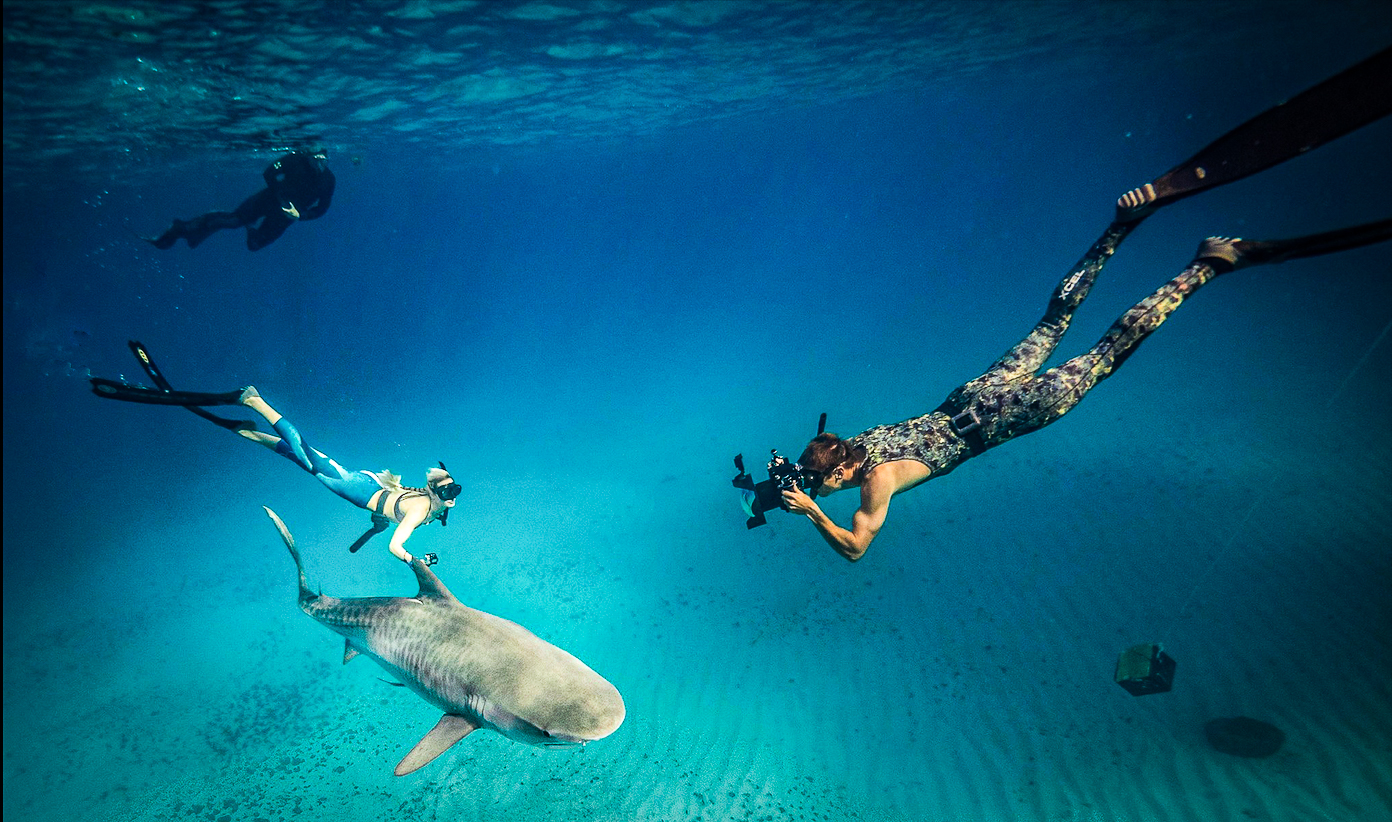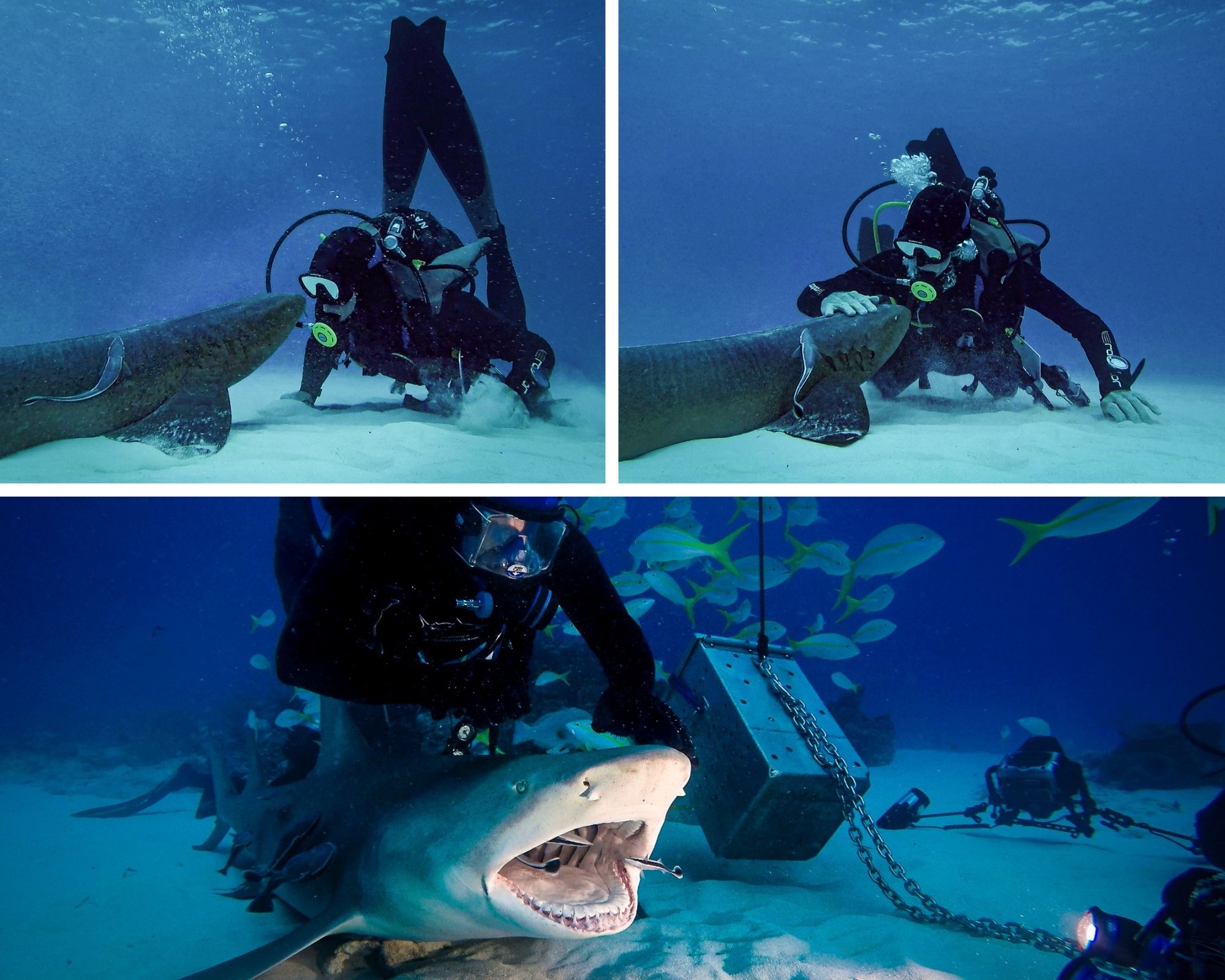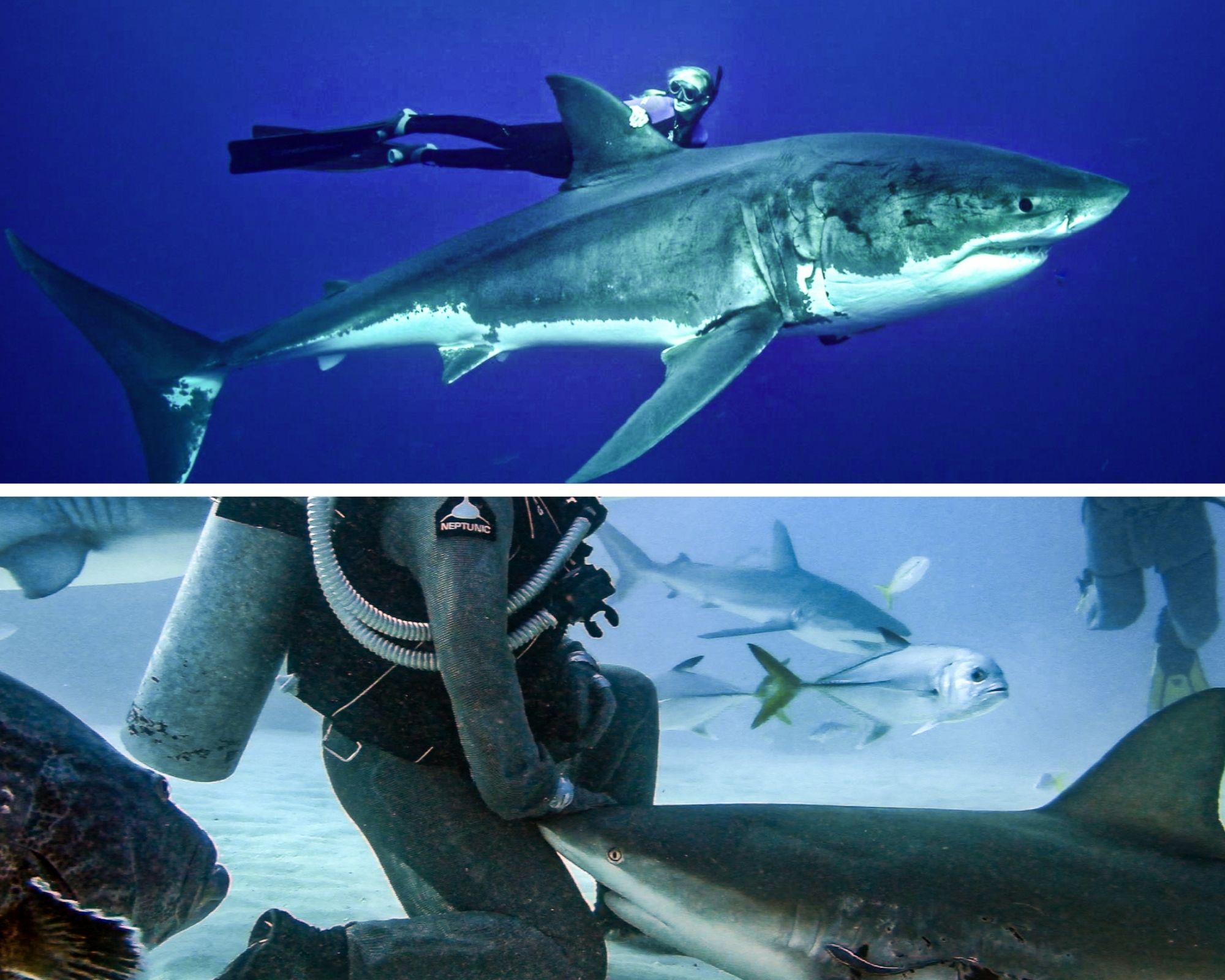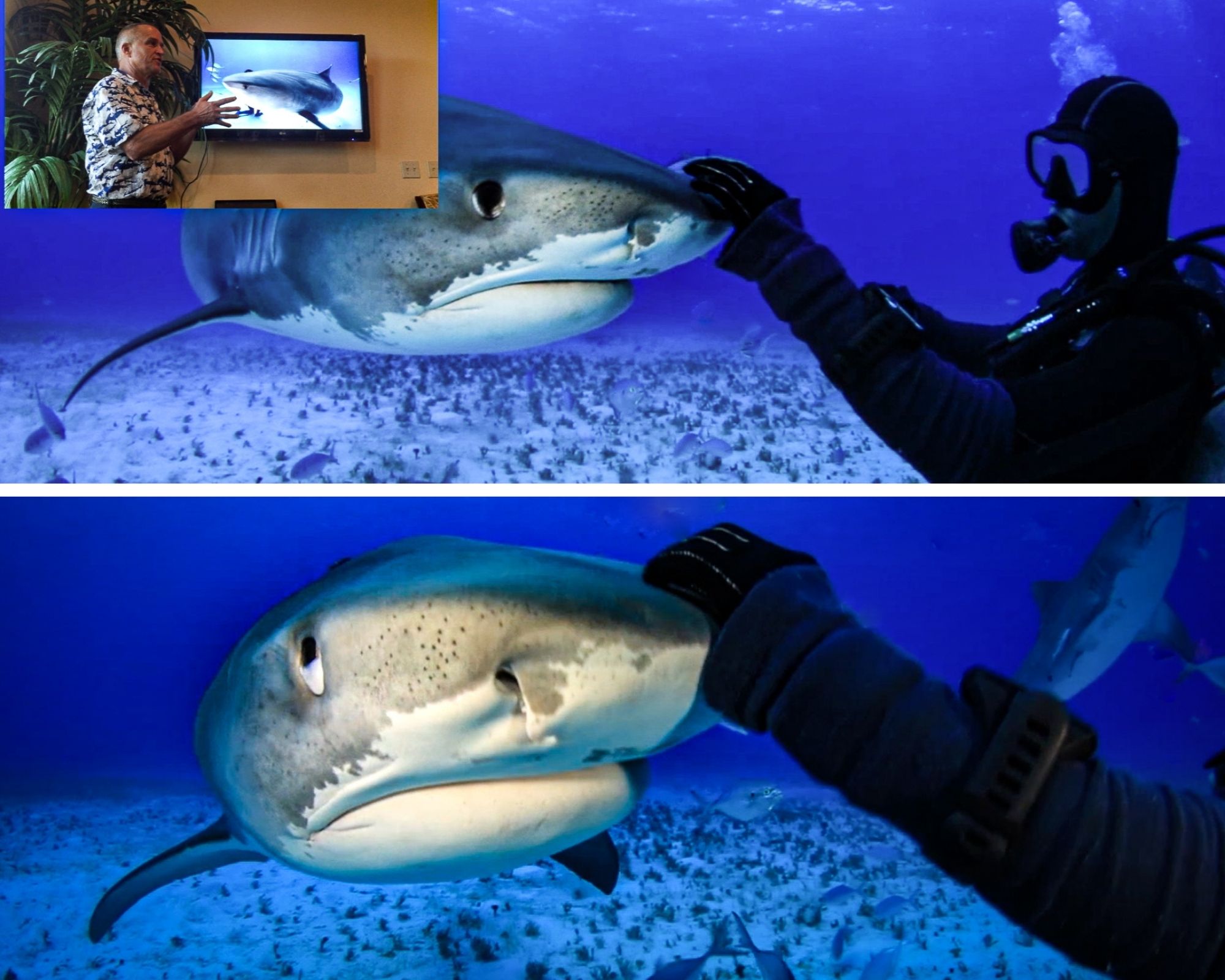A recent Wildlife Tourism Australia webinar ‘Wildlife With A Popularity Problem’ examined bats, sharks, and dingos. Tony Isaacson (DiveCareDare) spoke of his experience of diving with sharks. And of sentient sharks…
The webinar highlighted the bad reputation that sharks have. But the discussion also revealed the popularity of shark tourism. And how people want to dive to particularly see sharks. Tony described his experience with sharks displaying sentient behavior which drew a lot of interest.
So Irene Isaacson, Tony’s partner and photojournalist (iFotoTravel), interviewed him to tap into his knowledge of diving with sharks over the last 20 years.

Sharks have a Bad Reputation
Generally, in the media, sharks have a bad reputation. Indeed, human-shark interactions are scientifically categorized as varying degrees of ‘shark attack’.
In an academic paper, Christopher Neff and Robert Hueter suggest four categories of human-shark interaction. These were sightings (1), encounters (2), through to bites (3), and fatalities (4):
Categories for human-shark interactions:
- Category 1: Shark sightings: Sightings of sharks in the water in proximity to people. No physical contact takes place.
- Category 2: Shark encounters: Human-shark interactions in which physical contact occurs. No injury takes place (a minor abrasion on a person’s skin might occur because of contact with rough shark skin).
- Category 3: Shark bites: Incidents where sharks bite people. Results in minor to moderate injuries.
- Category 4: Fatal shark bites: Human-shark conflicts in which serious injuries take place. May involve one or more bites on a person. Incur significant blood loss and/or body tissue, with a fatal outcome.
Reference: Christopher Neff and Robert Hueter (2013), Science, policy, and the public discourse of shark “attack”: a proposal for reclassifying human – shark interactions. Journal of Environmental Studies and Sciences, 3: 65-73.
Shark Diving Ecotourism – A Category 1 Experience
There are a couple of ways that people can observe sharks. Some aquariums have amazing underwater shark observatories. Others even offer shark-diver interactions.
But more and more people want to see sharks in their natural environment. And so, interacting with sharks has become a popular type of diving experience. This is shark-diving ecotourism, and has evolved increasingly over the last 20 years or so.
So what does Shark Diving involve?
Before a shark dive can occur, the dive operator usually uses a shark ‘attractant’. This is to bring many, and hopefully different species of sharks to their site. Some dive sites such as Bega Lagoon in Fiji may attract up to 8 species at any one time.
Attractants may involve feeding the sharks, by hand or out of a bucket or wheelie bin. Or creating a chum slick or scent trail that may travel downstream for up to 20 kms. A rare technique even involves playing loud music. Apparently, some sharks, even great whites, respond to ACDC heavy metal music!
Before a dive, divers are given a briefing on how to conduct themselves in the presence of sharks. A shark dive is NOT just a normal reef dive.
There are many sources of tips on how to dive with sharks. PADI is the world’s leading scuba diver training organization. They even have an AWARE Shark Conservation Specialty course for divers and non-divers.
In general, there is a no-touch policy on these shark dives. The adventure revolves wholly around personal observations. Often at a close distance and with or without underwater photography.
What is the Monetary Value in Shark Tourism?
Shark tourism is a global industry increasing in popularity in recent years. This is due to more and more countries realizing the value of diving with sharks. Especially when the monetary value of a live shark exceeds that of a dead one hunted for its meat and fins. Here are some examples.
Global Value of Shark Ecotourism
In 2013 it was estimated that globally 590,000 shark watchers spent US$ 314M each year. This supported 10,000 jobs. In comparison, global shark fisheries’ worth was USD$ 630M. But this had been in decline for the previous ten years.
Based on those trends at that time, the number of global shark watchers was forecast to possibly double by 2033. This has a projected value of US$ 780M around the world.
(Reference: Cisneros-Montemayor, A. M., Barnes-Mauthe, M., Al-Abdulrazzak, D., Navarro-Holm, E., & Sumaila, U. R. (2013). Global economic value of shark ecotourism: implications for conservation. Oryx, 47(3), 381-388. DOI: 10.1017/S0030605312001718.)
Shark Diving in Indonesia
Closer to home was a study from James Cook University Australia in 2020. It looked at 24 shark tourism hotspots in Indonesia. For the year 2017, they estimated 188,000 shark tourists.
At that time, the annual median expenditure of these tourists was US$ 20M. This equated to 1.45 times the value of Indonesia’s annual shark exports.
Indonesia is a country where overfishing is the primary threat to shark populations. Unless the stakeholders are engaged and incentivized, Indonesia’s conservation efforts will have little effect. And their shark populations will continue to decline. The potential economic loss from shark tourism by 2027 is estimated at US$ 121M per year.
(Reference: Mustika, Putu Liza Kusuma, Ichsan, M., & Booth, H. (2020). The economic value of shark and ray tourism in Indonesia and its role in delivering conservation outcomes. Frontiers in Marine Science, 7. 261)
Shark Tourism in Palau
The tiny Pacific nation of Palau was declared a shark sanctuary in 2009. Shark tourism in Palau was studied by the Australian Institute of Marine Science in 2011. Diver tourism then contributed 39% of Palau’s GDP, US$ 218M. They estimated approx. 100 sharks inhabiting their prime dive sites.
Each shark thus had a value of US$ 179,000 per year to their tourism industry. And the lifetime value of a single shark was estimated at US$ 1.9M.
Shark Ecotourism in Australia
Up-to-date statistics on sharks in Australia are also hard to find. But one socio-economic survey in 2017 interviewed 711 tourist divers between March 2013 and June 2014. It collected information on expenditures related to diving. But also included accommodation, transport, living costs, and other related activities.
The total annual direct expenditure by shark divers in Australia then was a conservative $25.5M. Additional expenditure was provided by white shark and whale shark diving industries in Port Lincoln and Ningaloo Reef. This totaled $8.1M and $12.5M.
International tourists diving with white sharks also spent an additional $0.9M in airfares and other activities while in Australia.
This means shark divers spent a total of $47M in just that one year.

Tony comments “These figures show that the economic value of this type of tourism does not flow solely to the diving industry. It is also spread across the region where it is hosted. The value in 2013-14 would be a mere drop in the ocean when compared to Australia in 2021”.
(Reference: The economic value of shark-diving tourism in Australia. Charlie Huveneers, Mark G. Meekan, Kirin Apps, Luciana C. Ferreira, David Pannell, Gabriel M.S.Vianna, Sep 2017 Oceans Graduate School of Biological Sciences)
Are Fish, Including Sharks, Sentient?
So, back to sentient shark tourism. We must first understand what a sentient animal is. Put simply it is one that can perceive or feel things. Be it pain, emotion, fear, stress, joy, or love.
But as Tony notes “There is a spectrum of opinions about the relationship between animal rights, their welfare and tourist desires. Especially when relating to animals and their interaction with humans in a holiday environment. These debates are grounded in discussions of whether animals are sentient beings.”
Well, many of us have seen the 2020 movie My Octopus Teacher. It was filmed over eight years in the freezing waters of South Africa. It demonstrated an amazing relationship between an octopus and a human. Craig Foster, a burnt-out free diver and nature filmmaker.
Science also confirms animals are indeed sentient beings. An interesting read “What a fish knows: The inner lives of our underwater cousins” is a book written by Jonathan Balcome (Director, Human Society Institute for Science and Policy).
[Video: Jim Abernethy]
But Tony continues “However, official recognition of this would have problematic implications. Not only for recreational and commercial fishing but for shark control programs. And even catch and release fishing tournaments. It has the potential to shut down many existing practices if introduced as laws, policy, and protocols based on the science”.
Perhaps that discussion is best left for another day…
How is Sentient Shark Tourism different from Shark Diving?
Sentient shark tourism is based on the same principle of sharks regularly attracted to a dive site as discussed previously.
During such shark dives, they use learned ‘shark whispering’ skills. These demonstrate the sentient nature and behavior of those sharks. Interaction only occurs if the sharks are willing to participate. And this is only on their own terms. There is no form of coercion involved.
Techniques Involved in Sentient Shark Diving
But the major difference is that the diver/operator has experience in handling sharks. And has a long-term relationship with a shark, or sharks.
The exercise may involve placing a shark into a hypnotic trance. Called tonic immobility, it is induced by gently turning a shark on its back.
Also stroking the shark on the snout stimulates its sensory organs (pores) called the “Ampullae of Lorenzini”. Many sharks appear to really enjoy this. They repeatedly come back for more. A resemblance noted by many bystanders as appearing like a ‘puppy dog’.
This activity also demonstrates a Category 2 human-shark interaction. And an increasing number of operators around the world are expanding their shark diving businesses in this manner.
This is a relatively unknown phenomenon of sharks. These practices are a means of educating divers about the sentient nature of sharks. And the rest of the world through their subsequent social media posts.
Sentient Sharks and the Movies
Sentient shark activities thus lend themselves to enhancing shark diving tourism. But documentary and filmmakers are also captivated. Jaws was in fact a movie, not reality. But it had a huge, unfortunate negative effect on sharks for decades after. Depicting this more truthful character of sharks may quell this aging Hollywood depiction of ‘killer sharks’. Hopefully, this will help reveal to the world the more natural behavior of these rather awesome creatures of the ocean.
Using Sentient Behavior in Shark Research
In addition, ‘shark whispering’ techniques allow for less stressful tagging and handling methods for shark research.

Bottom: The map of Far North Queensland (FNQ) shows the distance traveled by that tiger shark over the next few months. [Photos: Biopixel]
Sentience allows for the Removal of Fishhooks
And as a ‘by-product’, sentient behavior also enables the removal of harmful fishhooks. Sharks are frequently injured by fishhooks. Many hooks permanently harm or even kill our ever-decreasing numbers of sharks if not removed.
Removing hooks whilst diving with sharks would not be possible if not for the trust built up over years. Some sharks develop strong relationships with a particular diver. Tony has personally dived with famous tiger shark Emma and Jim Abernethy (Florida USA).
He comments “Emma has had about 12 or more hooks removed over time. But the most famous was a very large commercial fishhook that lodged between her gill rakers and esophagus”.
“It had festered and ulcerated and was getting very painful. Jim spent a lot of preparation creating a personal arm guard. It was like a great big piece of stormwater pipe. So she could bite down on it while he would reach in to remove the hook”.
“But, on the day Emma worked out a way to do it without Jim using the arm guard. She actually bit down on a coral head so it effectively kept her mouth wide open. This is something a tiger shark would never normally do”.
“This allowed Jim, without any protection whatsoever to reach in and remove the hook. He triumphantly showed it to Emma. And for weeks after she would greet Jim with a wide-open mouth. It was as if to show Jim how well her wound was healing!”
The Bahamas, Sentient Shark Tourism Capital of the World
The Bahamas is not just one of the most popular regions in the world for shark tourism. It has become known for sentient shark tourism. It offers a large population of sharks in crystal-clear waters. These conditions make it perfect for diving photography and viewing marine life.
Many operators currently run such businesses in Bahaman waters. But one of the oldest and most reputable is Jim Abernethy.
But others also have a reputation for training divers in how to safely dive with sharks. For example, Cristina Zenato, the “Mother of Sharks” (Grand Bahama Island), and Ocean Ramsey (Hawaii). Both are renowned for their research, conservation, and ‘shark whispering’ capabilities.

Bottom: Cristina Zenato gives a Caribbean reef shark love and affection, who in the video kept coming back for more
[Photo: Tony Isaacson]
The Value of the Bahaman Shark Sanctuary
In 2011 the Bahamas declared its entire exclusive 200 nautical miles of coastline a shark sanctuary. Since, the population of sharks, rays, and skate have far exceeded the rest of the world. But outside of Bahaman waters, 24% are threatened or near-threatened with extinction.
Statistical analysis at that time estimated the tourism value of a single Caribbean reef shark at US$ 250,000. If killed its value was only USD$ 50. In 2014, a study of the Bahaman tourism industry revealed that US$ 114M was generated by shark-based tourism.
The Worth of a Single Live Shark
Tony had personal experience diving with Emma and Jim Abernethy at Tiger Beach in the Bahamas. He said “A single sentient tiger shark like Emma has been working with Jim for 20 years. Add up the number of charters where she alone has been the star of the show. Then knowing she could have a ‘working’ life span of 40 years. Her estimated value would then be US$ 15M”.
“But Emma also interacts with at least 4-10 other charters in the Bahamas. This would add a further possible US$ 60M to $100M in her lifetime”.
“In addition, do the math of additional accommodation, transfers, air travel, and restaurants over her lifetime. You are talking about a shark worth between US$ 100-200M. Just one individual animal.”

[Photo: Tony Isaacson]
Is Sentient Shark Tourism found in Australia?
Unofficially, yes. An example is the wonderful story of a small dive operator in Sydney. He has developed a beautiful relationship with a Port Jackson shark. This has taken over 7 years or more, with no feeding involved. Just love and affection. And this shark repeatedly seeks him out on his dives. Much to the surprise of other divers.
Osprey Reef and Diving Whilst Feeding Sharks
But sentient shark tourism on a commercial basis? When I asked this question of Tony, he said “The northwest tip of Osprey Reef (FNQ) is as far as I’m aware, the only place in Australia where there is a shark feeding dive operation. At least half a dozen different species of shark are involved. They recognize the sound of the charter boats”.
“The sharks aggregate in anticipation of being fed. But it’s a bit of a five-minute wonder really. Divers sit around in an amphitheater whilst a bin of frozen fish is hauled into location. As soon as the sharks get access to that, it’s just absolute bedlam. Chaos happens. And minutes later when the food is gone, everything is peaceful again.”
However, there is a move to possibly stop this shark feed in its current format. Tony went on to say “Interestingly if that should happen, we could go from a passive observation shark feed dive to potentially a Category 2 physical interaction. This would be Australia’s first sentient shark experience.”
Shark Diving without Feeding Sharks
It is a well-known fact that sharks get habituated to being fed at those dive sites. When the feeding is stopped for whatever reason, the sharks often don’t get the memo. They still visit the site, as Tony recalls his own experience:
“In Florida, a long-term shark feeding exercise was re-located from a natural amphitheater. It was deemed too close to shore. So they moved it from Florida into federal waters beyond the Six Mile limit”.
“But many dive operators kept taking their divers to the amphitheater. And the sharks continued to come in. Despite not being fed. As far as the sharks were concerned, the arrival of divers was still associated with a free meal of fish. And that particular shark dive site continues today”.
A Possible Sentient Shark Dive Site?
So, back to our Osprey dive site. “I think it could be trialed by those who know what they are doing. Just to see if it would work,” Tony says. “The sharks are already habituated. Over time they have recognized and developed strong bonds with some of the divers out there”.
“But I don’t think we have the political will right now. Not to officially put divers in physical contact with sharks. Certainly not here in Queensland. And I’m not even sure it would be condoned at the federal level”.
He goes on to say “Across the entire diving industry we generally have a ‘look and don’t touch’ policy. And that’s as much for occupational health and safety reasons, as it is to consider the welfare of the animal”.
“However, these animals appear to crave interaction. They have ‘recreational’ time in their day just as dolphins do. And as sentient creatures, they do appreciate making that time interesting for themselves”.
Top Tips on Diving with Sharks
In conclusion, I asked Tony for his top tips for safely enjoying water-based activities. Be it snorkeling, swimming, or diving with sharks, his list included:
- Stay as calm as possible
- Always keep eye contact with the shark
- Never allow yourself to be blind-sided
- Have ALL your skin completely covered
- Do not wear or carry anything silver or shiny that may resemble a fish or fish scales
- Sonic signatures attract sharks. It could be the sound of your dive or camera equipment. Even a half-filled Coca Cola bottle rattled in the water can stimulate the curiousity of a shark.
Tony went on to add “These are all good tips for anyone in the water. You don’t want to look like a fish at any time. So, a good general rule is to be vertical in the water and back-to-back with a buddy. Even if you are surrounded by sharks, you will be OK. As soon as you start swimming away horizontally, you look like somebody running away. And, you will be pursued.”
“There is a lot to be said for education, education, education. When anyone is in the water, education has a capacity to do more good than the sum total of ALL the shark nets and drum lines in the entire country of Australia”.
Tony Isaacson, 2021
ADDITIONAL VIDEO LINKS ABOUT SENTIENT SHARK BEHAVIOUR
- “This is Your Ocean”: Sharks – Official trailer
- “This is Your Ocean”: Sharks – Alternate trailer
- “Shark Affection Part 2: Are Certain Shark Species More Likely To Receive Affection”
- “Tears of a Mermaid” filmed at Tiger Beach in the Bahamas, this short film demonstrates the sentient nature of tiger sharks and their ability to have a human connection. Watch Hannah, an underwater performer, Jim Abernethy, and a great film crew pull off this most amazing shoot.
FOR FURTHER INFORMATION, CONTACT:
Tony Isaacson at: divecaredare@gmail.com
Irene Isaacson at: ifototravel@gmail.com

Really wonderful article. I spent 6 years living and working on remote islands and reefs on the GBR in the seventies studying fish. I definitely formed a relationship with the living communities of fish I studied over two years at One Tree Island. In particular a baby groper who was like a puppy dog and followed me whenever I did my surveys for the few months he hung around the area I was working. I never fed him, he just enjoyed the interaction. Terrie sent me the link to this article.
That’s so cool Alison. We just wish more people could have similar experiences with our marine animals. Then perhaps they may develop more respect for them and the ocean they live in. 😉